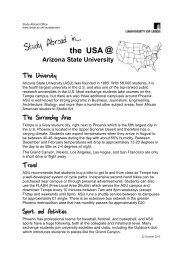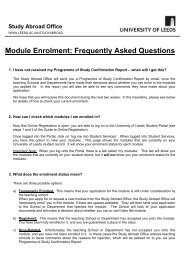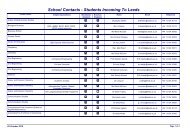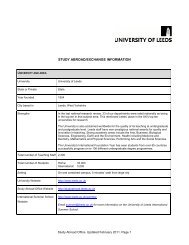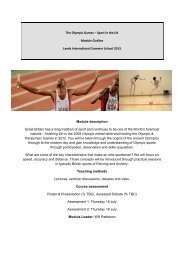1 LISS1002 The English Country House: A Social History ... - API
1 LISS1002 The English Country House: A Social History ... - API
1 LISS1002 The English Country House: A Social History ... - API
You also want an ePaper? Increase the reach of your titles
YUMPU automatically turns print PDFs into web optimized ePapers that Google loves.
<strong>LISS1002</strong> <strong>The</strong> <strong>English</strong> <strong>Country</strong> <strong>House</strong>: A <strong>Social</strong> <strong>History</strong><br />
Module Outline<br />
International Summer School 2012<br />
Module Description<br />
<strong>Country</strong> houses are one of Britain‟s greatest contributions to world culture, but who created them<br />
and why? Have they always functioned as „containers‟ for art collections or have they had deeper<br />
meanings and a wider social impact? Using Yorkshire‟s world-class country houses as case<br />
studies, this course will introduce you to:-<br />
<strong>The</strong> builders of the country house<br />
<strong>The</strong> rise and fall of the great estates<br />
<strong>The</strong> „upstairs‟ lives of the men, women and children who lived in the country house<br />
and the „downstairs‟ world of the men and women who served them<br />
<strong>The</strong> idea of a „court style‟ and its regional variations<br />
<strong>The</strong> often difficult relationship between patron and architect<br />
<strong>The</strong> allied arts of interior design and decoration<br />
<strong>The</strong> relationship between the aristocratic great house, the more modest<br />
gentleman‟s house and the villa<br />
Assessment<br />
Portfolio<br />
Submission date: 13 July 2012<br />
If the portfolio is submitted late without permission from the Course Leader, it will lose 5 marks for each working day<br />
after the deadline. Works handed in two weeks late will fail.<br />
Contact Hours: 2 X 90 minutes classes per day + 3 site visits<br />
Teaching Methods: Lectures, seminar discussions, visits<br />
Module Leader: Dr Kerry Bristol, Room 204 Old Mining Building, k.a.c.bristol@leeds.ac.uk<br />
1
Provisional Timetable<br />
Monday 2 nd July 9:30-11:00 - Landowners and land-based wealth<br />
Questions to consider:<br />
How did the pattern of land ownership change c.1550-1950?<br />
What has been the changing role of land-based wealth in British political and economic life?<br />
How is the concept of landownership represented within the country house?<br />
Recommended Reading:<br />
Christopher Christie, <strong>The</strong> British <strong>Country</strong> <strong>House</strong> in the Eighteenth Century (Manchester:<br />
Manchester University Press, 1999), pp. 4-25.<br />
Suggested Reading:<br />
David Cannadine, „<strong>The</strong> Landowner as Millionaire‟, in Aspects of Aristocracy (New Haven<br />
and London: Yale University Press, 1994).<br />
G.E. Mingay, <strong>English</strong> Landed Society in the Eighteenth Century (London: Routledge and<br />
Paul, 1963).<br />
F.M.L. Thompson, <strong>English</strong> Landed Society in the Nineteenth Century (London: Routledge<br />
& Kegan Paul, 1963).<br />
Monday 2 nd July 11:30-1:00 - <strong>The</strong> Builders of the <strong>Country</strong> <strong>House</strong><br />
Questions to consider:<br />
What motivated the building (or rebuilding) of country houses?<br />
How was the supply of money, labour and materials managed?<br />
Recommended Reading:<br />
Malcolm Airs, <strong>The</strong> Tudor and Jacobean <strong>Country</strong> <strong>House</strong>: a building history (Stroud: Alan<br />
Sutton, 1995), pp. 3-22.<br />
Suggested Reading:<br />
Charles Samaurez Smith, <strong>The</strong> Building of Castle Howard (London: Pimlico, 1997)<br />
John Summerson, „<strong>The</strong> Classical <strong>Country</strong> <strong>House</strong> in 18th-century England‟, in <strong>The</strong><br />
Unromantic Castle (London: Thames and Hudson, 1990), pp. 79-120.<br />
Richard Wilson and Alan Mackley, Creating Paradise. <strong>The</strong> Building of the <strong>English</strong> <strong>Country</strong><br />
<strong>House</strong> 1660-1880, 2000.<br />
Tuesday 3 rd July 9:30-11:00 - <strong>The</strong> Idea of the Architect<br />
Questions to consider:<br />
When is it legitimate to use the word „architect‟ when speaking of country house builders?<br />
How does the concept of abstract design relate to the emergence of the architect?<br />
Recommended Reading:<br />
H.M. Colvin, A Biographical Dictionary of British Architects 1600-1840, 4th edn (New<br />
Haven and London: Yale University Press, 2008), pp. 15-37.<br />
Suggested Reading:<br />
Richard Wilson and Alan Mackley, Creating Paradise. <strong>The</strong> Building of the <strong>English</strong> <strong>Country</strong><br />
<strong>House</strong> 1660-1880 (London: Hambledon and London, 2000) pp. 109-144.<br />
John Wilton-Ely, „<strong>The</strong> Rise of the Professional Architect in England‟, in <strong>The</strong> Architect.<br />
Chapters in the <strong>History</strong> of the Profession, ed. by Spiro Kostof (New York: Oxford<br />
University Press,1977), pp. 180-208.<br />
2
Tuesday 3 rd July 11:30-1:00 – <strong>Country</strong> <strong>House</strong> Planning<br />
Questions to consider:<br />
What can we learn about a building from its plan?<br />
What were the different functions of spaces and what role did they play in defining gender and<br />
class?<br />
Which spaces were public, which were private, and how/when did boundaries change?<br />
Recommended Reading:<br />
Mark Girouard, Life in the <strong>English</strong> <strong>Country</strong> <strong>House</strong> (New Haven and London: Yale<br />
University Press, 1978), pp. 120-162<br />
Suggested Reading:<br />
Jill Franklin, <strong>The</strong> Gentleman’s <strong>Country</strong> <strong>House</strong> and its Plan (London: Routledge & Kegan<br />
Paul, 1981).<br />
Alice T. Friedman, „Architecture, Authority, and the Female Gaze: Planning and<br />
Representation in the Early Modern <strong>Country</strong> <strong>House</strong>‟, Assemblage, 18, 1992, 41-61.<br />
Wednesday 4 th July 9:30-11:00 – <strong>The</strong> Villa<br />
Questions to consider:<br />
What were the social functions of the villa?<br />
What cultural associations informed the villa - taste, antiquarianism, wealth?<br />
Recommended Reading:<br />
James Ackerman, <strong>The</strong> Villa: Form, Function and Ideology (London: Thames and Hudson,<br />
1990), pp. 9-34<br />
Suggested Reading:<br />
<strong>The</strong> Georgian Villa, ed. by Dana Arnold (Stroud: Alan Sutton, 1996)<br />
Wednesday 4 th July 11:30-1:00 – Women<br />
Questions to consider:<br />
What role did women play in the social and economic life of the country house?<br />
Recommended Reading:<br />
Dana Arnold, „Defining Femininity: Women and the <strong>Country</strong> <strong>House</strong>‟, in Dana Arnold, <strong>The</strong><br />
Georgian <strong>Country</strong> <strong>House</strong>. Architecture, Landscape and Society (Stroud: Sutton, 1998),<br />
pp. 79-99.<br />
Suggested Reading:<br />
Lloyd Bonfield, „Marriage Settlements and the “Rise of Great Estates” the Demographic<br />
Aspect‟,<br />
Economic <strong>History</strong> Review, Vol. XXII (2nd series), 1979, 483-493.<br />
Christopher Clay, „Marriage, Inheritance and the Rise of Large Estates in England 1660-<br />
1815‟,<br />
Economic <strong>History</strong> Review, Vol.XXI (2nd series), 1968, 503-518.<br />
J.T. Cliffe, <strong>The</strong> World of the <strong>Country</strong> <strong>House</strong> in Seventeenth-Century England (New<br />
Haven: Yale<br />
University Press, 1999), chapter 4.<br />
Judith L. Lewis, „When a <strong>House</strong> is Not a Home: Elite <strong>English</strong> Women and the Eighteenth-<br />
Century <strong>Country</strong> <strong>House</strong>‟, Journal of British Studies, 48:2 (April 2009), 336-363.<br />
Trevor Lummis and Jan Marsh, <strong>The</strong> Woman’s Domain (London: Viking, 1990).<br />
Wednesday 4 th July 2:00-6:00 - Visit to Temple Newsam <strong>House</strong><br />
Thursday 5 th July 9:30-11:00 – Servants<br />
3
Questions to consider:<br />
Can the life of domestic servants be seen only as a reminder of the patriarchal and feudalistic<br />
values that dominated the social structure of the country house?<br />
Recommended Reading:<br />
Christina Hardyment, Behind the Scenes. Domestic Arrangements in Historic <strong>House</strong>s<br />
(London: National Trust, 1997, pp. 13-27.<br />
Suggested Reading:<br />
J.T. Cliffe, <strong>The</strong> World of the <strong>Country</strong> <strong>House</strong> in Seventeenth-Century England (New<br />
Haven: Yale University Press, 1999), chapter 6.<br />
Pamela Sambrook, Keeping their place: domestic service in the country house, 1700-<br />
1920 (Stroud: Sutton Publishing, 2005).<br />
Thursday 5 th July 11:30-1:00 - Eating and Drinking<br />
Questions to consider:<br />
What social rituals revolved around food and drink?<br />
What role did breweries play in the social and economic life of the country house?<br />
Recommended Reading:<br />
Pamela Sambrook and Peter Brears, <strong>The</strong> <strong>Country</strong> <strong>House</strong> Kitchen 1650-1900 (Stroud:<br />
Alan Sutton, 1996), pp. 11-29.<br />
Suggested Reading:<br />
<strong>The</strong> <strong>Country</strong> <strong>House</strong> Kitchen Garden 1600-1950, ed. by C. Anne Wilson (London:<br />
Sutton Publishing, in association with National Trust Enterprises, 1998).<br />
Friday 6 th July – Module Field Trip to Castle Howard<br />
Monday 9 th July 9:30-11:00 – Brotherton Library Special Collections<br />
Monday 9 th July 11:30-1:00 - Collecting and the Stuart Court<br />
Questions to consider:<br />
How widespread was art collecting in the seventeenth century?<br />
Why were paintings and sculpture collected and by whom?<br />
Recommended Reading:<br />
Jonathan Brown, Kings & Connoisseurs: Collecting Art in Seventeenth-Century Europe<br />
(Princeton, New Jersey: Princeton University Press, 1995), pp. 10-57.<br />
Suggested Reading:<br />
Rosalys Coope, „<strong>The</strong> Long Gallery; Its Origins, Development, Use and Decoration‟,<br />
Architectural <strong>History</strong>, 1986, 43-84.<br />
Alastair Laing and Nino Strachey, „<strong>The</strong> Duke and Duchess of Lauderdale‟s pictures at<br />
Ham <strong>House</strong>‟, Apollo, May 1994, 10-19.<br />
Catharine MacLeod and Julia Marciari Alexander, Painted Ladies. Women at the Court of<br />
Charles II (London and New Haven: National Portrait Gallery and Yale Center for British<br />
Art, 2002).<br />
Tuesday 10 th July 9:30-11:00 – Collecting in the Eighteenth Century<br />
Questions to consider:<br />
Who was/were the intended audience(s)?<br />
How were works of art displayed?<br />
What is the place of portraiture?<br />
What is the role of past art?<br />
4
Recommended Reading:<br />
Deborah Cherry, and Jennifer Harris, „Eighteenth-century Portraiture and the<br />
Seventeenth-century Past‟, Art <strong>History</strong>, 1982, 287-309.<br />
Suggested Reading:<br />
Gainsborough, ed. by Michael Rosenthal and Martin Myrone (London: Tate Gallery,<br />
2002).<br />
Andrew Moore and Larissa Dukelskaya, A Capital Collection: Houghton Hall and the<br />
Hermitage (New Haven and London: Yale University Press, 2002).<br />
Ian Pears, <strong>The</strong> Discovery of Painting: the growth of interest in the arts in England 1680-<br />
1768<br />
(London and New Haven: Yale University Press, 1988).<br />
Joshua Reynolds: <strong>The</strong> Creation of Celebrity, ed. by Martin Postle (London: Tate<br />
Publishing, 2005).<br />
Kate Retford, <strong>The</strong> Art of Domestic Life: Family Portraiture in England, c.1740-90 (London<br />
and New Haven: Yale University Press, 2006).<br />
Tuesday 10 th July 2:30-4:00 – <strong>The</strong> Grand Tour [please note the change of time]<br />
Questions to consider:<br />
What was the Grand Tour? Who went on it and why?<br />
In what ways did interest in antiquity help shape aesthetic attitudes in the eighteenth century?<br />
Recommended Reading:<br />
Brinsley Ford, „<strong>The</strong> Grand Tour‟, Apollo, December 1981, 390-400.<br />
Suggested Reading:<br />
Edgar Peters Bowron, Pompeo Batoni (1708-87) and His British Patrons (London: Greater<br />
London Council, 1982).<br />
Edgar Peters Bowron, and Joseph J. Rishel (eds.), Art in Rome in the Eighteenth Century<br />
(Philadelphia: Philadelphia Museum of Art, 2000).<br />
Edgar Peters Bowron, and Peter Björn Kerber, Pompeo Batoni. Prince of Painters in<br />
Eighteenth-Century Rome (New Haven and London: Yale University Press, 2007).<br />
Jeremy Black, <strong>The</strong> British Abroad: <strong>The</strong> Grand Tour in the Eighteenth Century (Stroud:<br />
Alan Sutton, 1992).<br />
Drawing from the Past. William Weddell and the Transformation of Newby Hall (Leeds:<br />
Leeds Museums and Galleries (City Art Gallery) in association with the West Yorkshire<br />
Archive Service, 2004).<br />
Grand Tour. <strong>The</strong> Lure of Italy in the Eighteenth Century, ed. by Andrew Wilton and Ilaria<br />
Bignamini (London: Tate Gallery, 1996).<br />
Steffi Roettgen, Anton Raphael Mengs 1728-1779 and his British Patrons (London: A.<br />
Zwemmer Ltd., in association with <strong>English</strong> Heritage, 1993).<br />
Wednesday 11 th July 9:30-11:00 – Nineteenth Century Collectors and Dealers<br />
Questions to consider:<br />
Who collected art and objects? Why did they buy them?<br />
How did the emergence of the „art professional‟ influence collecting practices?<br />
Recommended Reading:<br />
Oliver Garnett, „ “Sold Christie‟s. Bought Agnew”. <strong>The</strong> art collection of Lord Armstrong at<br />
Cragside‟, Apollo, April 1993, 253-258<br />
Suggested Reading:<br />
Clive Wainwright, <strong>The</strong> Romantic Interior (New Haven & London: Yale, 1989).<br />
William Buchanan and the 19th century art trade, ed. by Hugh Brigstocke (London: Paul<br />
Mellon Foundation, 1982).<br />
Wednesday 11 th July 12:00-4:00 – Visit to Harewood <strong>House</strong>, West Yorkshire<br />
5
Thursday 12 th July 9:30-11:00 - <strong>The</strong> End of the <strong>Country</strong> <strong>House</strong>? 1<br />
Questions to consider:<br />
Was the first half of the twentieth century one of „doom and gloom‟ for the aristocracy?<br />
Why were country houses demolished?<br />
Recommended Reading:<br />
David Littlejohn, <strong>The</strong> Fate of the <strong>English</strong> <strong>Country</strong> <strong>House</strong> (Oxford: Oxford University Press,<br />
1997), pp. 3-56.<br />
Suggested Reading:<br />
John Harris, No Voice from the Hall (London: John Murray, 1998).<br />
Peter Mandler, <strong>The</strong> Fall and Rise of the Stately Home (New Haven and London: Yale<br />
University Press, 1997), pp. 21-221, 311-354.<br />
Giles Worsley, England’s Lost <strong>House</strong>s from the Archives of <strong>Country</strong> Life (London: Aurum<br />
Press, 2002), pp. 7-24.<br />
Thursday 12 th July 11:30-1:00 - <strong>The</strong> End of the <strong>Country</strong> <strong>House</strong>? 2<br />
Questions to consider:<br />
Whose history was displayed in country houses after the war?<br />
How do modern heritage organisations such as the National Trust and <strong>English</strong> Heritage<br />
present the country house today? Do these differ from the presentation methods of private<br />
owners?<br />
In what ways do you think country houses and their contents should be displayed?<br />
Recommended Reading:<br />
Contemporary Cultures of Display, ed. by Emma Barker (New Haven and London: Yale<br />
University Press, 1999), pp. 200-228.<br />
Suggested Reading:<br />
John Cornforth, <strong>The</strong> inspiration of the past: country house taste in the twentieth century<br />
(Harmondsworth: Viking in association with <strong>Country</strong> Life, 1985), pp. 143-221.<br />
Adrian Tinniswood, <strong>The</strong> Polite Tourist. A <strong>History</strong> of <strong>Country</strong> <strong>House</strong> Visiting (London: <strong>The</strong><br />
National<br />
Trust, 1998), pp. 181-209.<br />
Friday 13 th : Visit to Oxford (all modules)<br />
6



